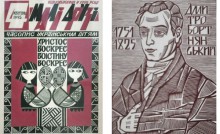The 21st fall salon “The High Castle” is open at the Palace of Arts. Conventionally this artistic event comprises several exhibits, one of which is inevitably dedicated to the memory of an outstanding Lviv artist. This year it is an exposition of graphic works by Myron Yatsiv (1929-96) – an artist, teacher, associate professor of the Lviv Academy of Arts, designer of more than 50 books, who drafted military insignia and uniforms for the contemporary army, participated in drafting the designs of Ukrainian banknotes, worked in the genre of ex-libris, and brought up a whole constellation of artists.
Yatsiv’s surviving family have some of his work in possession. Other drawings are owned by many museums, in particular, the Andrei Sheptytsky Museum in Lviv. According to the artist’s son Roman Yatsiv – also an artist, scholar, vice rector of the Lviv Academy of Arts and, by the by, The Day’s author and expert – soon another part of his father’s heritage will be handed over to the National Museum in Lviv.
“This exhibit emphasizes the national in art. This is important not only in what concerns commemorating my father; it matters a lot, given our current circumstances. Also this exposition is important because my father, being a priest’s son, was forced to conceal a lot of things. He was awarded no titles or decorations. He even was not member of the Union of Artists. In other words, he had no access to exhibits where he could have shown his historical cycles. My father’s works often ended up in the drawer,” shares Roman Yatsiv.
The exhibit comprises Yatsiv-senior’s works dating back to the last 20 years of his life. His most fruitful period coincided with the years of the Independence, since he now was free to legalize a lot of subjects. Besides, Roman Fedoriv, who was then chief editor at the magazine Dzvin (“The Bell”), placed some very necessary orders with him (i.e., commissioned him with designing his magazine’s covers). Before that, the artist had executed numerous series on historical and ethnographic subjects.
“Of course, the exhibit lets see only some fragments of my father’s work,” says Yatsiv Jr. “He taught the principles of composition at the Academy, jointly with his colleague, Professor Mykhailo Kurylych he developed the curriculum for students, where he (as early as in the 1960s-1970s) oriented them towards global modernism and Ukrainian tradition. This curriculum was quite advanced and posed an alternative to certain standards imposed by Moscow. It was very important for the contemporary situation, for education, because it implied freedom of thinking which was instilled in young people.”
Composition was Yatsiv’s strong side, he had a well-trained eye. He was able to construct any idea which had a logical center and a rhythmic system. Mostly it was the linocut. His son shared that in his last years Myron Yatsiv was often sick, so he exercised in gouache planning to make linocuts of those works. “Unfortunately, this was not to happen,” said Yatsiv Jr.
At the end of the interview I asked Professor Yatsiv what instructions he had received from his father. “Firstly, it was a motivation to orient myself towards all things national. Secondly, unrest and realization of the urge to keep developing myself personally. These lessons by my father, on how one needs to work with the tradition, are extremely important for me, because this is also visible in my work, it sits in my genes,” says Professor Yatsiv.
The exhibit of works by Myron Yatsiv at the Palace of Arts is open through December 2, just like all the other exhibits of the fall salon “The High Castle.”







